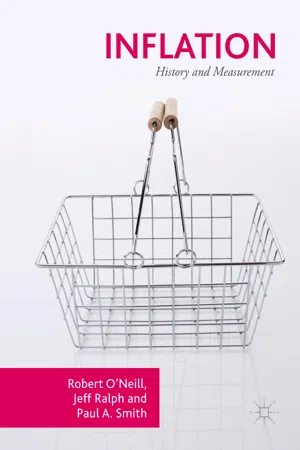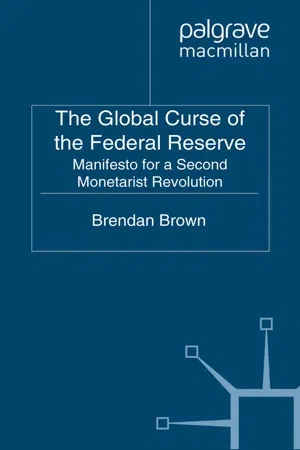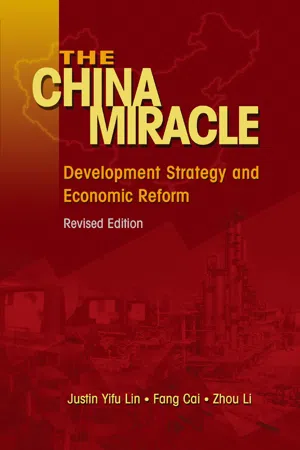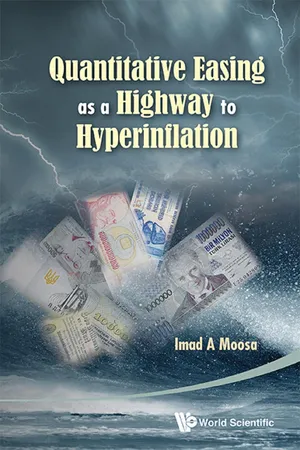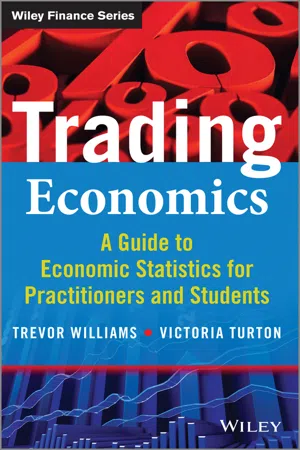Economics
Deflation
Deflation refers to a sustained decrease in the general price level of goods and services within an economy. This can lead to reduced consumer spending and investment, as individuals and businesses anticipate further price declines. Deflation can also increase the real burden of debt, making it more difficult for borrowers to repay loans.
Written by Perlego with AI-assistance
Related key terms
1 of 5
10 Key excerpts on "Deflation"
- eBook - PDF
Inflation
History and Measurement
- Robert O'Neill, Jeff Ralph, Paul A. Smith(Authors)
- 2017(Publication Date)
- Palgrave Macmillan(Publisher)
Alongside the definition of inflation, we will also often hear econo- mists make use of the term Deflation which the OED defines as a reduc- tion in the level of prices in an economy. 3 This refers to periods of time in which the level of prices, however measured, is declining, rather than increasing as is the more common situation in modern economies. This definition of Deflation can cause some confusion for students of Index Numbers as Deflation can also be used to refer to the practice of divid- ing a series of values measured in nominal 4 money at different periods of time by one plus the percentage change in a price index measured as a decimal so that the effect of changes in the price level between the peri- ods is removed and the amounts are measured at a constant price level. Where there is any ambiguity in the course of this book, we will attempt to clarify our meaning in the context of the situation being discussed. Economists will often also make reference to a period of disinflation which represents a period in which inflation is falling from a previous level to a new lower level (for an example of this being used in context see 3 Surprisingly, the definition seems incomplete compared the earlier statement referring to infla- tion. However, Deflation might also be defined as an increase in the purchasing power of money. 4 By this we mean the amounts measured in money in the time period they occur, so for example, company accounts are stated in nominal amounts, and the value of the pounds values are meas- ured in changes across the years due to inflation. 24 R. O’Neill et al. Roger 2009). For example, in the past three decades, the UK has expe- rienced a period of disinflation as inflation has fallen to a relatively very small, but generally positive, level. - Mark Mobius(Author)
- 2020(Publication Date)
- Wiley(Publisher)
67*Murray N. Rothbard, economist, historian, and political theorist: “‘Deflation' is usually defined as generally falling prices, yet it can also be defined as a decline in the money supply which, of course, will also tend to lower prices. It is particularly important to distinguish between changes in prices or the money supply that arise from voluntary changes in people's values or actions on the free market; as against deliberate changes in the money supply imposed by governmental coercion.”68Central Banks Cause Deflation
*Peter Cresswell: “There are two kinds of ‘Deflation’: progressive and destructive. Central banks and their ‘stabilisation' make the first impossible, and the second more likely.”69Deflation Is Caused by an Increased Production of Goods and Services
*George Reisman, professor emeritus of economics at Pepperdine University: “Deflation is usually thought to be a synonym for falling prices. There could be no more serious error in all of economics. Calling falling prices ‘Deflation’ results in a profound confusion between prosperity and depression. This is because the leading cause of falling prices is economic progress, whose essential feature is an increasing production and supply of goods and services, which, of course, operates to make prices fall.”70People Should Accept Deflation
*Carlos Ghosn, chairman and CEO of Groupe Renault: “To face Deflation, you have to have people accepting it and not reacting to it.”71Deflation Is Bad
*Robert Kiyosaki, founder of Rich Dad Company: “Deflation isn't good, and inflation is easier to cure than Deflation.”29*Lawrence Summers, former director of the National Economic Council: “Deflation and secular stagnation are the macroeconomic threat of our time.”72*Jack Kemp, former US secretary of housing and urban development: “The real problem is Deflation. That is the opposite of inflation but equally serious to the borrower.”- eBook - ePub
The Coming Bond Market Collapse
How to Survive the Demise of the U.S. Debt Market
- Michael G. Pento(Author)
- 2013(Publication Date)
- Wiley(Publisher)
stable means not easily moved. However, to the men and women who control our money supply, it means increasing about 2 percent a year. So determined are they that the economy not be met by the evil Deflationary monster that they create inflation of 2 percent (as measured by the phoniest of inflation measurements known as the Personal Consumption Expenditure Price Index). This is done as a buffer or wall to block evil Deflation from coming in—because once that evil Deflation monster enters the economy, they fear he will never leave.The word Deflation is a little nebulous in that it is used by economists in a technical way to describe a decline in the money supply. Most laypeople view Deflation as a generalized decline in prices. Inflation , in turn, would refer to an increase in prices or, more technically speaking, an increase in the money supply or the fear of such a future increase in its supply that causes a decline in the purchasing power of the currency.As a follow-up to my introduction on decreasing prices, I have decided to start my critique of Fed myths with the Keynesian Fed-lore of the “Deflationary death spiral”; this Fed-lore is very widely held and promulgated. The men and women at the Federal Reserve believe that a slight increase in prices is a sign of a growing economy and falling prices are devastating.Let’s put this Keynesian Fed-lore to the test and see how it holds up.In an economic environment of increasing productivity accompanied by a static money supply, one would assume that prices would slightly decrease. As an industry becomes more productive and makes better use of technology, those technological advances aid in the reduction of costs associated with producing the product. Profit margins improve, and in a competitive environment, businesses will pass most of these savings on to consumers. So with truly stable prices, the costs of many items would go down, and that would be a positive result; it would indicate that businesses were leveraging productivity to increase profit margins and decreasing the price of goods to consumers. However, outside of technology, we rarely see this materialize.Those at the Fed view any Deflation as harmful, regardless of the cause. Ben Bernanke has said that “Deflation is in almost all cases a side effect of a collapse in aggregate demand—a drop in spending so severe that producers must cut prices on an ongoing basis in order to find buyers.”1 - eBook - PDF
The Global Curse of the Federal Reserve
Manifesto for a Second Monetarist Revolution
- B. Brown(Author)
- 2011(Publication Date)
- Palgrave Macmillan(Publisher)
The shock of German political and economic Phobia of Deflation Menaces Prosperity 43 collapse occurring through 1931 and the massive US monetary contrac- tion surely explained a plunge in equity markets. In the ‘good cyclical Deflations’ of textbook theory, by contrast, the Deflation phase should be accompanied by a re-bound of equity markets which leads the econ- omy forward, as investors anticipate the recovery of profits further ahead in a continuing climate of negative real risk-free rates (expecta- tions of price recovery mean low or zero nominal rates are negative in real terms). It is useful, before proceeding in this discussion of Deflation phobia, to back-track first to key definitions. Clarity on these can help deal with the horror, which is, in fact, phobic rather than rationally based. Definitions of Deflation – popular, Austrian school and monetarist The most popular definition of Deflation is a period, generally under- stood to last for at least several quarters, of a falling price level. A less popular definition found in older economic textbooks, most particularly associated with the Austrian school (see Bagus, 2003), describes Deflation as a sustained monetary disequilibrium in which a ‘shortage of money’ drives ‘the price level’ downwards. (Note, however, that Austrian school economists are adverse to using aggregates such as ‘price level’, stressing instead the huge heterogeneity of economic life). In particular, von Mises defines Deflation not as declining prices per se but as ‘a diminution of the quantity of money (in the broader sense), which is not offset by a corresponding diminution of the demand for money (in the broader sense) so that an increase in the objective exchange value must occur’ (Von Mises, 1981). Money shortage in the sense of the Austrian definition would go along with market rates of interest rising far above so-called natural or neutral level. - eBook - PDF
The China Miracle
Development Strategy and Economic Reform (Revised Edition)
- Justin Yifu Lin, Fang Cai, Zhou Li(Authors)
- 2003(Publication Date)
- The Chinese University of Hong Kong(Publisher)
In the concluding section, the chapter discusses other policy options available to the Chinese government and concludes that the most effective way to combat the Deflation is to invest in rural infrastructure that are complementary to the use of domestic appliances. 9.1 The Demand Side of Deflation Deflation is an economic phenomenon characterized by continuous 2. National Bureau of Statistics of China, China Statistical Yearbook, 2001 . Beijing: China Statistics Press, 2001, p. 281. 9. Deflation in China since 1998 259 decline in the price level throughout the economy. Theoretically, a Deflation is either due to an overall drop in demand in an economy, or due to a sharp increase in supply. The demand drop could result from credit contraction, which leads to an increase in interest rates, and a decline in investment and current consumption. The decline in investment and consumption may lead, in turn, to enterprises oper -ating below capacity. This would further reduce the investment and labour income. Consumption will thus decline further. Demand de -cline can also originate from the collapse of financial and real estate bubbles, and lead to shrinkages in national wealth, which will then result in further declines in consumption. At the same time, it will lead to an increase in bad loans and a decrease in credit supply and investment demand. The other cause of Deflation, oversupply, can arise from a productivity increase due to technological innovation, or from over-investment, which causes the increase in production capacity to exceed the increase in demand. Theoretically, all the factors mentioned above can result in Deflation. Chinese economists tend to emphasize the demand-side factors in their analyses of current Deflation in China. 3 However, the question of what is the main factor of the current Deflation can only be answered by empirical analysis. - Imad A Moosa(Author)
- 2013(Publication Date)
- WSPC(Publisher)
Chapter 1INFLATION, Deflation, DISINFLATION AND ALL THAT1.1.What is Inflation?It is often said that inflation is inevitable, like death and taxes. This is probably because, as Sir Frederick Keith-Ross mentions, “inflation is like sin; every government denounces it and every government practices it” (Makochekanwa, 2007). Historical stories about inflationary episodes proves that it is a phenomenon that has existed ever since money was used as a medium of exchange. Inflation is a topic that receives significant attention in the media, with regular features, reports and interviews. It is an issue that is often debated by politicians in Parliament and election campaigns, let alone economists and business executives.The reason why inflation is treated with “respect” is that it affects everybody in various ways. It is an important consideration during mortgage payments and in determining the cost of essential goods and services required for survival and those that make our lives more pleasant. We anticipate news about whether the central bank will decide to cut or raise interest rates, with inflation typically being the prime consideration (at least for some central banks). Most of us are fascinated by documentaries on the great inflation in Germany during the 1920s and how it relates to the rise of Adolf Hitler. Inflation has broad implications for the state of the economy and whether or not we can keep our jobs or find new ones. While it is regarded as one of the four macroeconomic variables closely monitored by policymakers (the others being growth, employment and the balance of payments), it is often the prime indicator that triggers drastic policy actions. “Inflation targeting” is a more common concept than “output targeting”, “employment targeting” or “balance of payments targeting”.Inflation is defined in different ways, but, in general, the phenomenon is about rising prices of goods and services (hence, the cost of living). As the prices of goods and services rise, the value (or purchasing power) of money falls in the sense that a monetary unit (say a dollar) buys less and less goods and services resulting in a diminishing basket. This is why inflation is viewed as a “persistent” erosion of the value of the money. While it cost 60 pounds to purchase a first class ticket on the Titanic in 1912, there is no way these days that this amount can buy a ticket to cross the Atlantic (let alone the Pacific) in a first class cabin on an ocean liner (perhaps 10,000 pounds can do the job). It is for this reason that we give our children more pocket money than what our parents gave us. People are typically nostalgic to the “good old days” when things were very cheap — the culprit being inflation.- eBook - PDF
Trading Economics
A Guide to Economic Statistics for Practitioners and Students
- Trevor Williams, Victoria Turton(Authors)
- 2014(Publication Date)
- Wiley(Publisher)
4 Inflation Inflation is always and everywhere a monetary phenomenon in the sense that it is and can be produced only by a more rapid increase in the quantity of money than in output. Milton Friedman 1 WHAT IS INFLATION? Inflation tells us the changing (increasing) price of a range of goods or services; basically how much of something we can get for our money. The rate of change of prices – the speed at which the price of goods and services that are bought by households or businesses alter – is called inflation. But prices can also fall, in a process called Deflation, sometimes termed negative inflation. Inflation is more common than Deflation, or at least it has been in the last 50 years or so, and so it has become associated with changes in the price of goods and services. Historically, however, price falls were as common as price rises, as we will see later. Both inflation and Deflation have advantages and disadvantages, which we will explore in more detail later in this chapter. THE HISTORY OF INFLATION Inflation has been around for a long time, but, as Figure 4.1 shows, the level of prices (the index) really only rose consistently and sharply in the UK from the 1970s onwards. This was after the US came off the gold standards and the Bretton Woods system of fixed exchange rates, which had prevailed after the Second World War, ended. Money was now backed by government fiat and trust rather than by gold. And exchange rates were no longer fixed but allowed to float freely. This seems to have led to a rapid rise in the level of prices or, in other words, to the Retail Prices Index. Before that, for hundreds of years, the level 1 Friedman, M., The Counter-Revolution in Monetary Theory (1970). 100 Trading Economics Retail Price Index (1987 = 100) 0 10 20 30 40 50 60 70 80 90 100 1264 1296 1328 1360 1392 1424 1456 1488 1520 1552 1584 1616 1648 1680 1712 1744 1776 1808 1840 1872 1904 1936 1968 2000 Figure 4.1 Price index over time. - eBook - ePub
The Age of Deleveraging
Investment Strategies for a Decade of Slow Growth and Deflation
- A. Gary Shilling(Author)
- 2010(Publication Date)
- Wiley(Publisher)
I've identified seven types of inflation/Deflation that may occur individually but often happen simultaneously or in sequence as they interact with and promote each other. The huge spending on the Vietnam War and Great Society programs, starting in the mid-1960s, spawned first commodity inflation in the early 1970s, then a wage-price spiral and general CPI-style inflation. Currency Deflation and general inflation both resulted from excessive money creation in Germany in the 1920s, China in the late 1940s, and Zimbabwe today.Financial asset Deflation in stocks in the years 2000–2002 and again in 2008–2009 as well as the tangible asset Deflation in houses have sired a consumer saving spree along with other forces that should generate CPI-style general Deflation. Commodity Deflation has also curtailed spending by producers and therefore slower global growth and CPI Deflation. Protectionism resulting from the Deflationary, high-unemployment global economy may spur competitive devaluations—currency Deflation that leads to retaliation and slows worldwide growth. That would enhance other forms of Deflation.Five of the seven forms of Deflation are in place, and are largely understood by investors. Increasingly, observers realize that cuts in wages and hours worked are being used to reduce labor costs in addition to layoffs (wage-price Deflation). The collapse in 2008 in commodities, and more recent weakness, is obvious to all (commodity Deflation). Commercial real estate Deflation is increasingly seen as another serious threat to the financial system and adds to housing price weakness (tangible asset Deflation). The 2000–2002 and 2007–2009 stock collapses as well as the more recent slide are vivid to most investors (financial asset Deflation). The dollar's strength in late 2008 and early 2009 as well as in early 2010 is well known.The least accepted variety of Deflation remains general price declines, or CPI Deflation, as we've dubbed it. If we're right and the CPI and PPI fall chronically by 2 to 3 percent per year, that will be a big shock to almost everyone else who expects the opposite. Unlike CPI inflation, which is generally considered undesirable, Deflation comes in two flavors: the good Deflation of excess supply and the bad Deflation of deficient demand. - Hans Neisser(Author)
- 2016(Publication Date)
The third degree is reached when, due to the international Deflationary pressure, profits fall below the critical mark, creating a discrepancy between savings and investment and even Deflationary anticipations. A new autonomous center of Deflation would then arise. These distinctions help, too, in interpreting the decline in the quantity of imports. A fall in the quantity of exports would be responsible directly for a reduction in imports cor-responding to the amount of imported foreign raw materials embodied in the exported goods, or, as we may say, for the decline in non-available imports. The decline in exports would, itself, reduce the purchasing power of the income-re-ceivers in export industries and would create a cumulative secondary decline in demand already described in Chapter III. These secondary effects are associated with monetary events: since a decline in exports by itself would not reduce the domestic volume of purchasing power 8 there would be, other things being equal, a tendency to immediate re-ex-pansion of demand to the old level which would induce a rise of available imports to the old level. Credit restriction and, ultimately, an outflow of gold would check this re-ex-pansion; or, to express it otherwise, imposed Deflation would be the mechanism generating secondary unemployment. It follows that any decline of available imports that is not due either to substituting previously imported goods by domestic production or to the physical destruction of domestic equip-ment utilizing the imported producers' goods, possesses a Deflationary character. The two types of Deflation, imposed Deflation and auton-omous Deflation, may have different effects on the monetary mechanism. As long as Deflation is only imposed, the demand 8 The primary unemployed may hoard, but scarcely for a considerable rime. On the contrary, they will solicit consumption credit, thus increasing the money flow. See the more detailed analysis in the last chapter.- eBook - ePub
Money and Markets
A Doctrinal Approach
- Maria Cristina Marcuzzo, Alberto Giacomin, Maria Cristina Marcuzzo, Alberto Giacomin(Authors)
- 2007(Publication Date)
- Routledge(Publisher)
as such. Thus a special section on Deflation-induced stagnation in Japan has been inserted in latest-vintage textbooks (see, e.g., Blanchard 2003), while retaining the idea that under normal conditions falling money wages and prices, far from being harmful to the economy, cause it to move down along a well-behaved AD function.2 ‘By the Keynes-effect I mean the hypothesis, granted by Keynes, that an increase in the supply of money, measured in stable purchasing power and caused by falling prices, reduces the rate of interest and thereby favourably influences the volume of investment’ (Haberler 1958: 491, fn. 3).3 It may be observed, en passant, that – although Fisher’s analysis is conducted on the basis of the quantity theory of money – the fall in prices can be conceived of as the consequence of nothing but the ‘distress selling’ of products aimed at raising the money required to pay off debt, thus making reference to the quantity theory of money unnecessary.4 As pointed out in Keynes (1931), the fall in the price of assets, which takes place as a part of the general process of Deflation, is also liable to cause serious embarrassment of the banks, with negative repercussions on their lending policy.5 In the preparatory notes for The Monetary Theory of Production – this being the original title of what was to become The General Theory of Employment, Interest and Money – Keynes makes the point that Marx was right in pointing out that ‘the nature of production in the actual world is not, as economists seem often to suppose, a case of C-M-C', i.e. of exchanging commodity (or effort) for money in order to obtain another commodity (or effort). That may be the standpoint of the private consumer. But this is not the attitude of business, which is a case of M-C-M'
Index pages curate the most relevant extracts from our library of academic textbooks. They’ve been created using an in-house natural language model (NLM), each adding context and meaning to key research topics.
